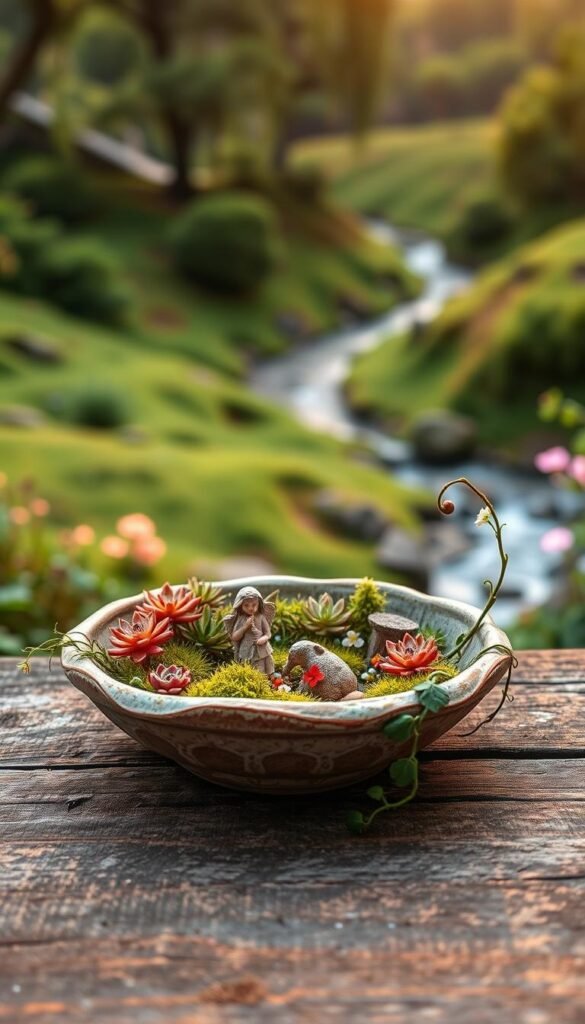Imagine having a lush, thriving ecosystem that fits on your desk or windowsill. Miniature gardens in containers let you craft stunning natural displays using small plants and creative arrangements. These compact creations work equally well in sunny living rooms or low-light offices, adapting to your space and schedule.
You don’t need a green thumb to get started. These tiny landscapes combine succulents, mosses, and decorative elements to tell visual stories. A sandy setup with cacti might evoke warm desert vibes, while seashells and air plants could mimic oceanfront serenity. Each theme becomes a conversation piece that reflects your personality.
What makes these projects special is their flexibility. You can refresh designs seasonally or stick with low-maintenance options that thrive year-round. They’re perfect for adding life to apartments, patios, or workspaces without demanding constant care.
This guide will show you how to balance colors, textures, and proportions for eye-catching results. You’ll learn to choose plants that complement each other and discover styling tricks that make small spaces feel magical. Let’s explore how to turn simple containers into living art that sparks joy every day.
Exploring the Magic of Coastal Garden Themes
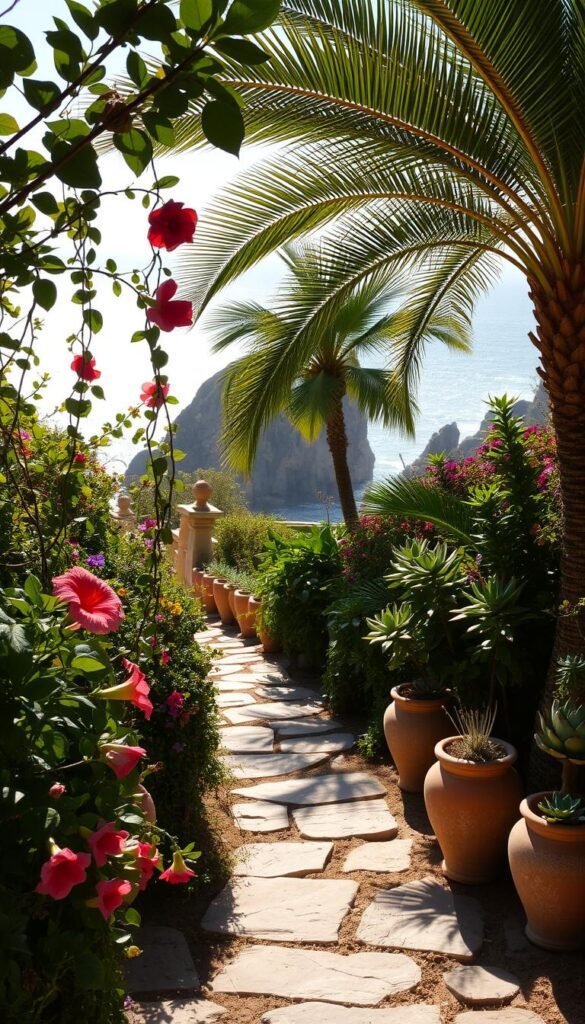
Bring the calming essence of the seaside into your home with a coastal-themed miniature landscape. Start by layering light-colored sand to mimic sun-bleached shores, then add texture with pebbles and driftwood fragments. These elements work together to create a breezy, relaxed atmosphere, whether you’re crafting a beachy display or enhancing a fairy garden.
Choosing Fine Sand and Seashells
Opt for ultra-fine sand that feels soft underfoot—literally. This base layer replicates real shorelines while letting water drain easily. Scatter shells in irregular clusters, mixing sizes and colors for a natural look. Add small driftwood pieces to complete the tactile experience of walking along a windswept beach.
Crafting a Miniature Sailboat Accent
Position a tiny sailboat at an angle, as if it’s about to ride the next wave. Use weathered wood or folded paper for a rustic charm. Surround it with blue-green succulents like Sedum dasyphyllum to mimic ocean hues. These plants thrive in sandy soil, making them ideal for low-maintenance setups.
Complete the scene with dwarf grasses that sway like coastal dune vegetation. For depth, place taller accessories like mini palm trees toward the back. This layered approach tricks the eye into seeing vast horizons in your compact creation. Salt-resistant containers help preserve materials, ensuring your seaside vibe lasts season after season.
Desert-Inspired Dish Gardens: Embracing Arid Elegance
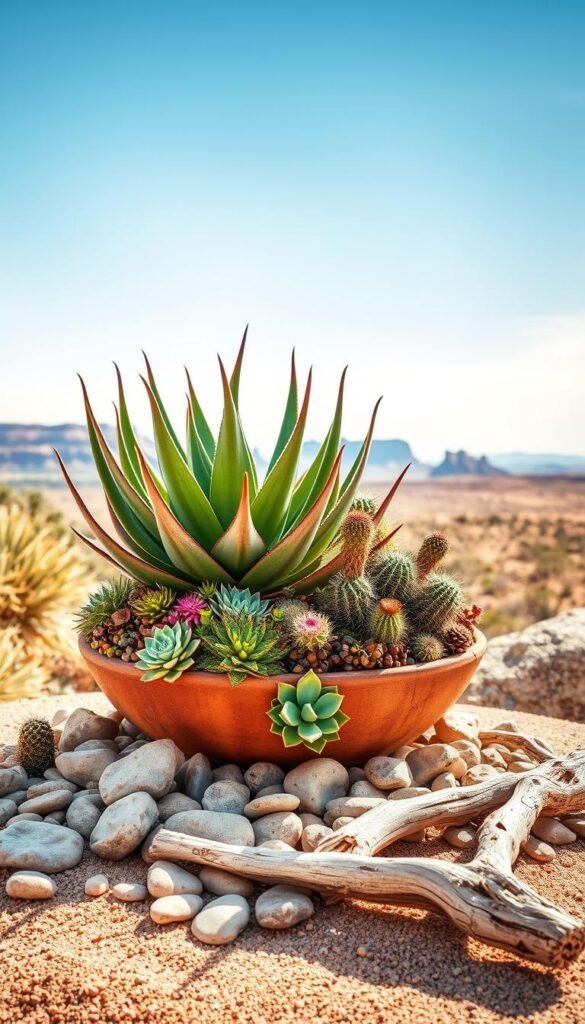
Discover how to bring the serene elegance of desert vistas into your home. Start by choosing a bright, sunny spot for your container. A wide, shallow pot filled with cactus-specific soil provides the perfect foundation. This mix drains quickly, protecting roots from moisture buildup.
Selecting Cacti and Succulents
Pick small varieties like barrel cacti or feathery sedums. These thrive in tight spaces and add striking shapes. Cluster them unevenly to mimic natural growth. Leave room between each plant for airflow and visual balance.
Creating Winding Sandy Paths
Use pale sand or crushed quartz to design meandering trails. Gently press materials into place with a spoon handle. Add miniature clay houses where paths meet—these become focal points. For texture contrast, scatter smooth pebbles near spiky specimens.
Water sparingly—once every three weeks works for most setups. Rotate the container monthly so all sides receive equal light. With minimal effort, your dry-climate scene stays vibrant year-round.
Enchanted Fairy Garden Concepts and Ideas
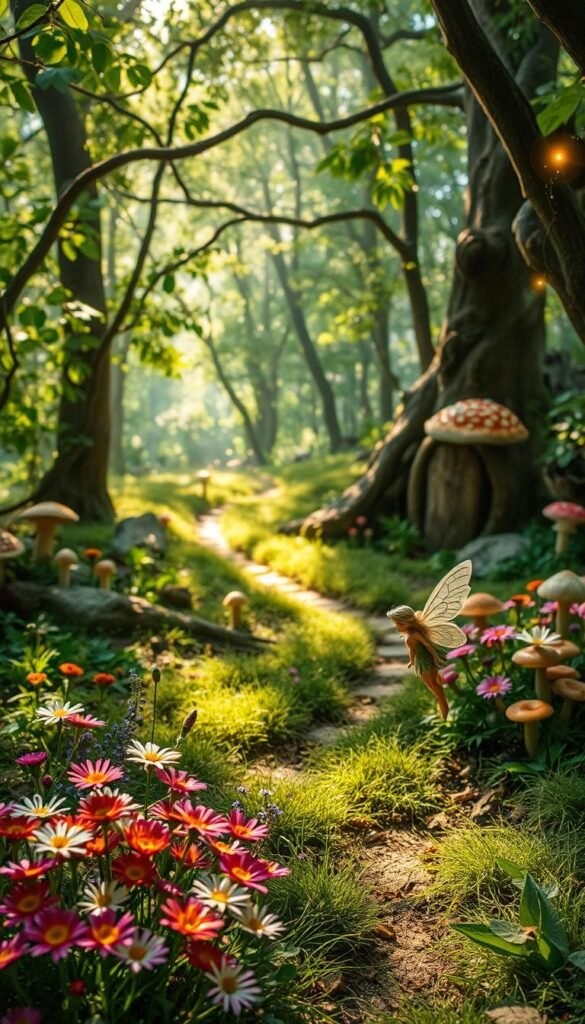
Transform ordinary containers into whimsical realms where imagination takes root. These tiny worlds blend natural materials with playful details to create spaces that feel alive with possibility. Let’s explore how to build environments where fairies might pause to rest their wings.
Designing Tiny Fairy Homes and Accessories
Start by constructing cottages using bark strips or flat stones for walls. Dried grasses or coconut fibers make excellent thatched roofs—layer them like shingles for weather-resistant charm. Position these houses near mossy “lawns” or under miniature trees for hidden appeal.
| Material | Best Use | Visual Effect |
|---|---|---|
| Birch bark | Cottage walls | Rustic texture |
| Pine cones | Roof tiles | Scaled appearance |
| Twigs | Fences | Natural boundary |
Incorporating Miniature Details with Charm
Add cobblestone paths using pea gravel or broken terracotta pieces. “A fairy garden isn’t complete without secrets,” says one enthusiast. “Hide tiny doors in tree trunks or create window boxes with blooming sedum.”
Use creeping thyme between stones for fragrant ground cover. Baby’s breath adds airy white blooms that suggest fairies might dance among them at night. Keep elements proportional—a bench shouldn’t tower over your cottage.
Finally, personalize with unique accessories: a tiny watering can by a pebble well, or a miniature lantern glowing near the entrance. These touches make your creation feel lived-in and magical.
Unique Dish Garden Themes: Coastal, Desert, Fairy, and More
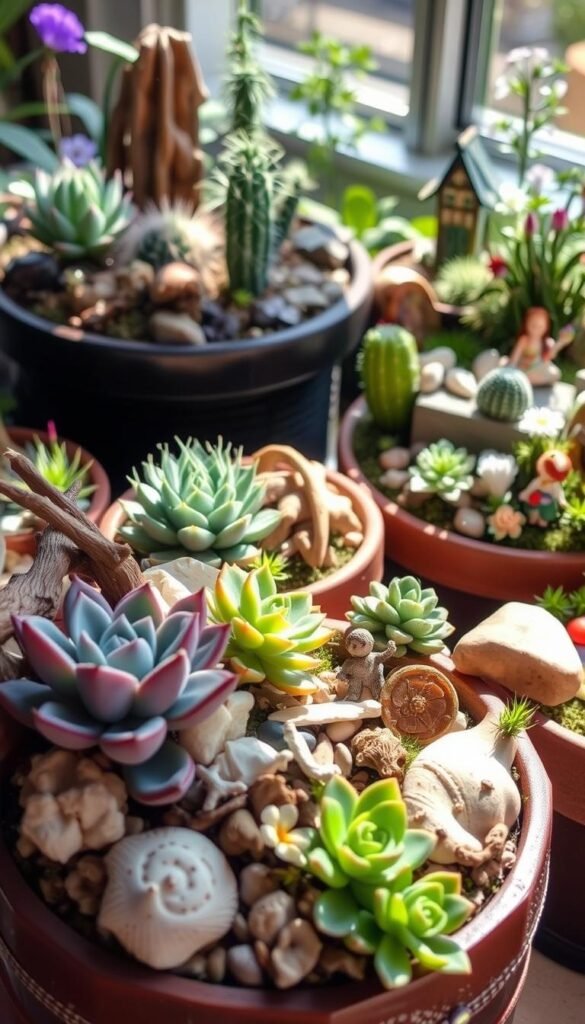
Crafting a miniature world lets you blend nature with personal stories in any space. These living scenes adapt to your lighting setup, whether bright kitchens or dim offices. A prehistoric jungle with tiny dinosaurs thrives under grow lights, while a moonlit meadow glows with reflective stones.
Containers shape your theme’s personality. Wide clay pots suit sprawling desertscapes, while tall glass jars become enchanted forests. Match materials to your vision—driftwood bowls for beach scenes or polished cement for modern looks. Patio container gardening ideas prove even outdoor setups can tell vivid stories.
Themes spark emotions through clever design. A cottagecore layout with violets and lace curtains feels nostalgic, while geometric succulent patterns create calm order. Studies show arranging plants lowers stress by 14%—your garden becomes both art and therapy.
| Theme Type | Best Container | Key Plants | Mood Created |
|---|---|---|---|
| Zen Retreat | Shallow stone tray | Bonsai juniper, moss | Peaceful focus |
| Mountain Escape | Terracotta pot | Alpine sedum, thyme | Adventurous spirit |
| Storybook Scene | Wooden crate | Mini roses, ferns | Whimsical joy |
Mix elements across themes for unexpected magic. Combine desert stones with fairy lights for a starlit canyon effect. Rotate accessories seasonally—pumpkins in fall, glittery branches in winter. Your creations stay fresh while reflecting changing interests.
These gardens teach nature’s rhythms through hands-on play. Kids learn responsibility caring for tiny ecosystems, while adults find creative flow. Every theme becomes a bridge between imagination and the tangible world.
Imaginative Design Elements for Exceptional Dish Gardens
Light becomes your secret ingredient for transforming compact spaces into captivating displays. Thoughtful lighting choices elevate ordinary arrangements into interactive scenes that shift moods from day to night. Start by considering how illumination can guide the eye and amplify your theme’s story.
Using Glow-in-the-Dark Pebbles for Magical Pathways
Create winding trails that mimic starlit walks through enchanted woods. Press glow pebbles into soil or sand bases during daylight hours. These resin stones absorb UV rays, emitting a soft blue-green radiance for 8-10 hours after sunset.
Space pebbles 1-2 inches apart for subtle guidance. Cluster them near miniature benches or bridges for focal points. Pair with creeping thyme between stones—its tiny leaves won’t block the glow.
Integrating Illuminated Accents
Solar-powered LED lights offer hassle-free sparkle. Bury coin-sized units behind rocks to uplight dwarf conifers. Waterproof string lights wrapped around twig arches add whimsy without overpowering plants.
For safety, use low-voltage systems (3V or less) and seal battery packs with silicone. Mirrored tiles placed at angles bounce light onto shaded areas, while clear quartz crystals create rainbow prisms in sunlight.
| Light Type | Best Use | Runtime |
|---|---|---|
| Solar LEDs | Path edges | 6-8 hours |
| Fiber optics | Water features | Continuous |
| Glow moss | Ground cover | 4-5 hours |
Rotate light sources seasonally—warm white for autumn, cool tones for summer. These elements keep your creation fresh while maintaining its magical core.
Integrating Natural Plants and Unique Flowers
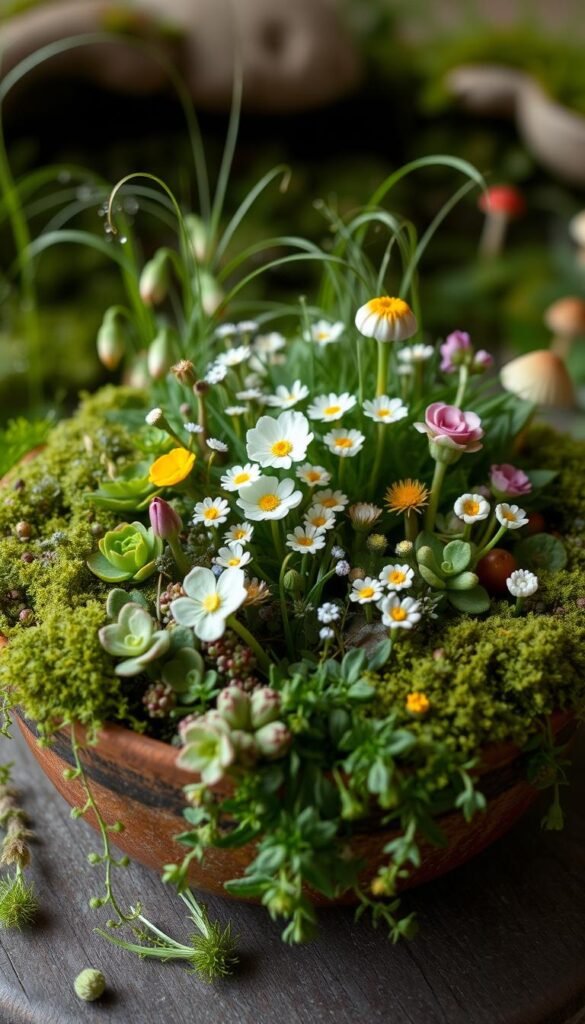
Your plant choices determine whether your tiny ecosystem thrives or fades. Start by selecting species that match your theme’s scale and light conditions. Dwarf varieties work best—they maintain their proportions naturally, saving you from constant trimming.
Choosing Dwarf Varieties for Miniature Settings
Opt for compact herbs like miniature lavender or creeping thyme. These stay under 4 inches tall while releasing soothing scents. For pops of color, try violas or dwarf marigolds. Their small blooms add vibrancy without overwhelming the scene.
Pair flowering plants with staggered bloom cycles. Early-blooming pansies give way to summer-blooming sedums, creating year-round interest. Use this table to plan seasonal color:
| Plant | Bloom Period | Height |
|---|---|---|
| Pansy | Spring/Fall | 3-4″ |
| Mini Marigold | Summer | 2-3″ |
| Sedum | Late Summer | 1-2″ |
Layer plants by height for depth. Place taller specimens like chives at the back, with mosses hugging the front. Well-draining soil prevents root rot—mix sand with potting soil for succulents, or use peat for moisture-loving violets.
Rotate plants quarterly. Swap winter-blooming cyclamen for spring azaleas to keep your setup fresh. This approach maintains visual appeal while letting each species thrive in its ideal season.
Crafting Fairy Cottages with Thatched Roofs and Natural Materials
Build cozy hideaways that spark wonder in compact spaces. Start by gathering bark strips or flat stones to form cottage walls. These materials blend seamlessly with outdoor settings while offering weather-resistant durability. Let your design reflect storybook charm or woodland mystery.
DIY Tips for Rustic Character
Layer dried grasses over a twig frame to create textured roofs. Secure coconut fibers with floral wire for lasting structure. Add depth with miniature windows made from clay shards or acorn caps. For a lived-in look, position your cottage near fairy garden inspiration like mossy rocks or creeping thyme.
Construct pathways using pea gravel pressed into damp soil. Edge walkways with glow pebbles for moonlit magic. Surround your creation with baby’s breath—their delicate blooms suggest tiny celebrations might happen after dark.
Protect outdoor setups by sealing wood with beeswax. Rotate structures seasonally to prevent sun damage. Blend styles by mixing cottage elements with cottagecore aesthetic touches like lace curtains or miniature washlines. Your tiny abode becomes both art and invitation for imagination to flourish.

